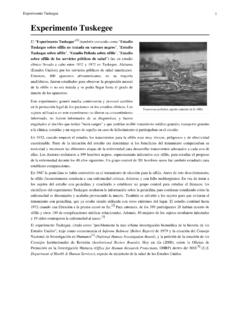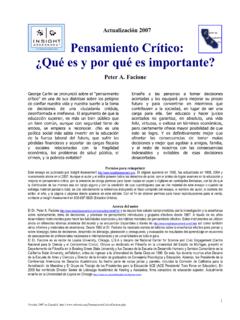Transcription of Two Faces of Power Peter Bachrach, Morton S. Baratz The ...
1 Two Faces of Power Peter Bachrach, Morton S. Baratz The Americun Political Science Review, Volume 56, Issue 4 (Dec., 1962), 947-952. Your use of the JSTOR database indicates your acceptance of JSTOR's Terms and Conditions of Use. A copy of JSTOR's Terms and Conditions of Use is available at , by contacting JSTOR. at or by calling JSTOR at (888)388-3574, (734)998-9101 or (FAX) (734)998-9113. No part of a JSTOR transmission may be copied, downloaded, stored, further transmitted, transferred, distributed, altered, or otherwise used, in any form or by any means, except: (1) one stored electronic and one paper copy of any article solely for your personal, non-commercial use, or (2) with prior written permission of JSTOR and the publisher of the article or other text.
2 Each copy of any part of a JSTOR transmission must contain the same copyright notice that appears on the screen or printed page of such transmission. The American Political Science Review is published by American Political Science Association. Please contact the publisher for further permissions regarding the use of this work. Publisher contact information may be obtained at The American Political Science Review Gl962 American Political Science Association JSTOR and the JSTOR logo are trademarks of JSTOR, and are Registered in the Patent and Trademark Office. For more information on JSTOR contact G2000 JSTOR.
3 Sat Sep 2 22:37: 15 2000. TWO Faces OF POWER1. P ETER B A C H R A C H A N D M ORTON S. Baratz . Bryn Mawr College VW I*on(bept of Power remains elusive despite which predetermine their conclusions. Our the rP\*tW and prolific outpourings of case argument is cast within the frame of our central studk~ on community Power . Its elusiveness is thesis: that there are two Faces of Power , nei- clram:Lt kally demonstrated by the regularity of ther of which the sociologists see and only one disa~r~~(~mont as to the locus of community of which the political scientists see. pow&~ 1jt $ween the sociologists and the political sciemt id S.))
4 ,Sociologically oriented researchers I. have c(u~si&enUy found that Power is highly Against the elitist approach to Power several cent 4 i w( 1, d Glc scholars trained in political criticisms may be, and have been levelled. One s(*ien(dc 11a~e just as regularly concluded that in has to do with its basic premise that in every WGr'* (~onln~unities Power is widely human institution there is an ordered system of Pre~u II I :i My, tShis explains why the latter group Power , a Power structure which is an integral St)+ \s ii 5(4f pluralist, its counterpart eli- part and the mirror image of the organization's tist.)))))
5 Stratification. This postulate the pluralists T~~cIY~ ~~~en~s no room for doubt that the emphatically-and, to our mind, correctly- sharpl~~ (li~crgont findings of the two groups are reject, on the ground that the prt dwt, wt of sheer coincidence, but of nothing categorical can be assumed about Power fun(lti~i~(!~~Lal differences in both their under- in any community.. If anything, there seems lying a \su mpt ions and research methodology. to be an unspoken notion among pluralist re- The 1): Ji tit&al scient,ists have contended that searchers that at bottom nobody dominates in a these di fh~mws in findings can be explained by town, so that their first question is not likely to be, the fault y :ipproach and presuppositions of the Who runs this community?))
6 , but rather, Does socidwjd~. We contend in this paper that the anyone at all run this community? The first plurali; s t,hemst4vcs have not grasped the query is somewhat like, Have you stopped beat- who10 tl>uth of the matter; that while their ing your wife?, in that virtually any response cri ticis:] 1s (bf tlw elitists are sound, they, like the short of total unwillingness to answer will supply elitisk ut ilk: m approach and assumptions the researchers with a Power elite along the lines presupposed by the stratification 1 l'hi+ p:i+er is an outgrowth of a seminar in Prol&~nl~ of Power in Contemporary Society, Equally objectionable to the pluralists-and conduc~~J jointly by the authors for graduate to us-is the sociologists' hypothesis that the st~~d~.)
7 Nt 5 and \lndergraduatc majors in political Power structure tends to be stable over time. science :I ~1 economics. Pluralists hold that Power may be tied to 2 Co]l1;1:U(~, for example, the sociological studies issues, and issues can be fleeting or persistent, pro- of I'l+.~ i 1 hihi or, Corn*munit y Pofwer Struci? ure voking coalitions among interested groups and (Ch:hpo1 I Ml, 1953) ; Roland Pellegrini and citizens, ranging in their duration from momen- ChaI& IL Chalks, Absentee-owned Corpora- tary to semi-permanent.. To presume that the tion> :U t 1 t ~on!munity Power Structure, Asmer- set of coalitions which exists in the community at ictj n Jo v rnd oj Sociology, Vol.)
8 61 (March 1956), any given time is a timelessly stable aspect of pp. 41:; 19; ant1 Robert 0. Schulze, E c o n o m i c social structure is to introduce systematic inaccu- 1 lCbTllili:i 111 s md Community Power Structure, racies into one's description of social A ~~~~~ri~~i /I 8oc~ol~&~l IZeview, Vol. 23 (February 19XQ, I)[). 3-9; with political science studies of A third criticism of the elitist model is that it W:&MJ s. Sayrc and Herbert Kaufman, Govern- wrongly equates reputed with actual Power : i?? {/ ALYt' !i' ht% My (New York, 1960); Robert A. If a man's major life work is banking, the pluralist I)::hi, M,o Go~)r& ( N e w H a v e n , 1 9 6 1 ) ; a n d presumes he will spend his time at the bank, and X bri (~11 !]}
9 +1. Len g a n d George Belknap, A Re- not in manipulating community decisions. This so:{ r& ljrogr:~ 111 on L e a d e r s h i p a n d Decision- presumption holds until the banker's activities M:&ing i n M~~tro~~olitan Areas (New York, and participations indicate otherwise.. If we &vcrIj ~111 t al Mfairs Institute, 1956). See also X&o11 \\-. PoMy, How to Study Community 3 See especially N. W. Polsby, op. cit., p. 475f. Po wt;r : The Pluralist Alternative, Journal of 4 Ibid., pp. 476. ~h!~[ i,*s , -cc d. 22 (*4ugust, 1960), pp. 474-84. 5 Ibid., pp. 478-79. 947. 948 THE AMERICAN POLITICAL SCIENCE REVIEW.]}
10 Presu nail that, 1 he banker is really engaged in II. running t hc tbommunit,y, there is practically no There is no gainsaying that an analysis way d &~con~irming this notion, even if it is grounded entirely upon what is specific and t,ot:Q ~~~~*oncous. On the other hand, it is easy to visible to the outside observer is more scien- tipoL Lilfl i):Lnk(lr who really does run community tific than one based upon pure speculation. To al'f:Grs u hen we presume he does not, because his put it another way, activit ios will make this fact If we can get our social life stated in terms of This is not an exhaustive bill of particulars; activity, and of nothing else, we have not indeed there ~c flaws other than these in the sociologi- succeeded in measuring it, but we have at least cal n-~&J and methodology7-including some reached a foundation upon which a coherent sys- which the pluralists themselves have not tem of measurements can be built up.















